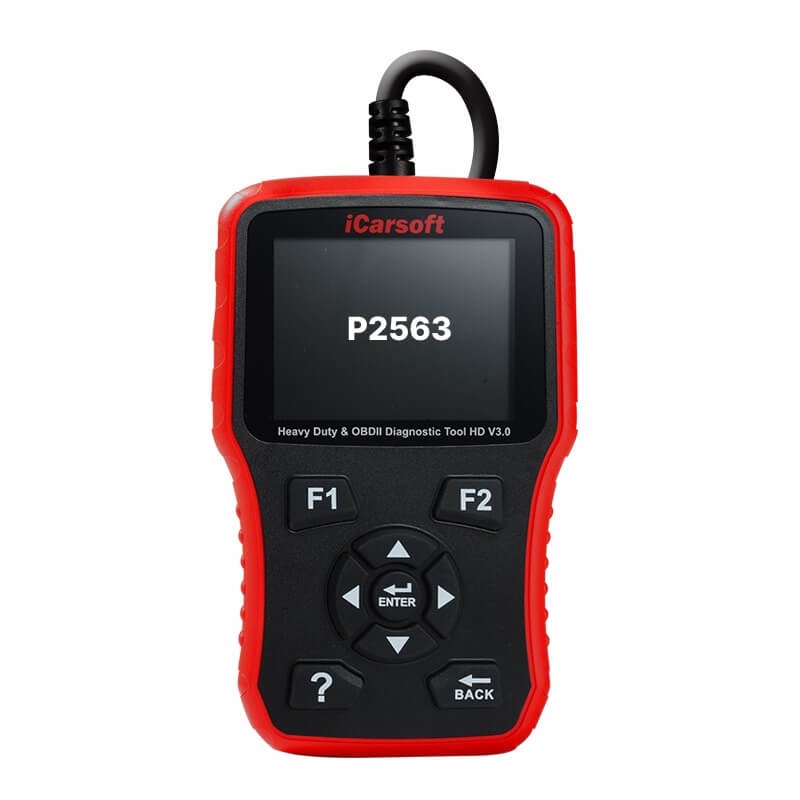P2563 – Turbocharger Boost Control Position Sensor Circuit
POSTED IN pcodes
Welcome to our article on the P2563 code, which pertains to the Turbocharger Boost Control Position Sensor Circuit. If you’re experiencing issues with your turbocharger performance or noticing symptoms like a check engine light, poor turbocharger functionality, or even getting stuck in limp mode, this code may be the culprit.
The P2563 code is triggered when the Powertrain Control Module (PCM) does not receive the proper signal response from the turbocharger boost control position sensor. This sensor plays a crucial role in providing data to the PCM about the position of the vanes in the turbocharger, ultimately affecting the boost pressure. When the sensor malfunctions or sends abnormal signals, it can lead to performance issues and potential engine damage.
In this article, we will explore the meaning of the P2563 code, its possible causes, common symptoms, diagnosing techniques, and potential fixes. Whether you decide to seek professional assistance or attempt a do-it-yourself diagnosis and repair, we’ve got you covered.
Key Takeaways:
- The P2563 code relates to the Turbocharger Boost Control Position Sensor Circuit.
- Symptoms include a check engine light, poor turbocharger performance, and being stuck in limp mode.
- Possible causes are a faulty turbocharger boost control position sensor, malfunctioning turbocharger solenoid, or electrical issues.
- Diagnosing the issue involves scanning codes, checking for soot buildup, measuring actuator resistance, and inspecting the wiring harness.
- Fixing the P2563 code is best left to professionals, but advanced DIYers may attempt to replace the turbocharger boost control position sensor themselves.
What Does the P2563 Code Mean?
The P2563 code indicates a Turbocharger Boost Control Position Sensor Circuit Range/Performance issue. The turbocharger boost control position sensor, also known as the turbocharger vane position sensor, measures the position of the vanes in the variable geometry turbocharger. This position correlates to the boost pressure. The sensor sends this information to the PCM, which adjusts the boost pressure based on the readings. This ensures that the engine is not overboosted or underboosted, which can lead to engine damage or reduced power. If the sensor does not provide the correct signal or sends an abnormal signal, the PCM will log the P2563 code.
Possible Causes of the P2563 Code
When the P2563 code is triggered, it indicates a potential issue with the Turbocharger Boost Control Position Sensor Circuit. There are several possible causes for this code:
Buy tested tuning file for Adblue / EGR / DPF / Adblue off now!
- A defective Turbocharger Actuator: The turbocharger actuator is responsible for controlling the flow of exhaust gases to the turbine wheel, which affects the boost pressure. If the actuator is faulty, it may not be able to regulate the boost pressure correctly, leading to the P2563 code.
- A malfunctioning Turbocharger Boost Sensor: The turbocharger boost sensor measures the pressure of the intake air and sends this information to the engine control module. If the sensor is not functioning properly, it may provide incorrect readings or fail to send any signal at all, resulting in the P2563 code.
- Issues with the Turbocharger Vanes: The turbocharger vanes are responsible for adjusting the airflow and boost pressure in the turbocharger. If the vanes become stuck or bind due to dirt, debris, or soot buildup, they may not move as intended, causing the P2563 code to be triggered.
- Soot buildup: Soot accumulation on the turbocharger vanes or other components can hinder their movement and interfere with proper turbocharger operation, potentially leading to the P2563 code.
If you encounter the P2563 code, it is essential to address these potential causes to resolve the issue and prevent further damage to your vehicle’s turbocharger system.
Common Symptoms of the P2563 Code
When encountering the P2563 code, several common symptoms may manifest. Being aware of these indicators can help you identify and address the issue promptly. Here are the key symptoms associated with the P2563 code:
- Check Engine Light: The illumination of the check engine light is often the first sign that something is amiss. If you notice the check engine light persistently lit, it may be an indication of the P2563 code.
- Low Turbo Boost: Another symptom is experiencing low or no turbo boost. When the turbocharger fails to supply adequate boost pressure to the engine, you may notice reduced acceleration and overall engine performance.
- Lack of Power: A lack of power during acceleration or when the vehicle is under load is also a common symptom. You may find that your vehicle is unable to reach its usual level of power and struggles to maintain speed.

Now that we have explored the symptoms associated with the P2563 code, let’s move on to diagnosing the issue in the next section.
Diagnosing the P2563 Code
The P2563 code is a generic OBD-II code that can apply to any turbocharged vehicle. If you lack confidence or skill in diagnosing your turbocharger-equipped vehicle, it is recommended to bring it to a professional mechanic. However, if you have the necessary technical knowledge and experience, you can attempt to diagnose the issue yourself.
Here are some steps you can take to diagnose the P2563 code:
- Scan the codes: Use an OBD-II scanner to retrieve the trouble codes from your vehicle’s computer system. This will help identify the specific issue causing the P2563 code.
- Check for soot buildup: Inspect the turbocharger and its components for any signs of excessive soot buildup. Soot accumulation can restrict the movement of the turbocharger vanes, leading to performance issues.
- Measure actuator resistance: Use a multimeter to measure the resistance of the turbocharger actuator. Compare the measured value with the manufacturer’s specifications to determine if the actuator is functioning correctly.
- Inspect the wiring harness: Thoroughly inspect the wiring harness that connects the turbocharger components, including the boost control position sensor. Look for any signs of damage, loose connections, or corroded terminals.
Remember, diagnosing and resolving issues related to the turbocharger system requires a careful and methodical approach. If you encounter any difficulties or are unsure about proceeding with the diagnosis, it is always best to consult a professional mechanic for assistance.

Fixing the P2563 Code
When it comes to fixing the P2563 code, it is highly recommended to seek professional repair services, especially if you lack the necessary tools and expertise. However, if you consider yourself a DIYer with advanced technical knowledge, you can attempt to test and replace the turbocharger boost control position sensor yourself.
To ensure a successful repair, it is crucial to consult a reliable repair manual or refer to an online repair database for the proper procedures. These resources provide step-by-step instructions, diagrams, and invaluable tips to guide you through the process effectively and efficiently.
Remember, every vehicle model can have its own unique specifications and requirements, so it is essential to follow the specific instructions relevant to your vehicle when testing and replacing the turbocharger boost control position sensor.
Performing the repair correctly is vital for optimal performance and to prevent any potential damage to your vehicle’s turbocharger system. Before you start the repair process, make sure you have all the necessary tools, including a socket set, wrenches, and a multimeter to test electrical connections.
Follow the instructions diligently, and if you encounter any difficulties or uncertainties during the repair, it’s always a good idea to seek professional advice or assistance. Professionals have the expertise and experience to address any unforeseen challenges and ensure the repair is completed correctly.
| Benefits of Professional Repair | Benefits of DIY Repair |
|---|---|
|
|
Whether you opt for professional repair or decide to tackle the repair yourself, resolving the P2563 code is crucial for maintaining the performance and longevity of your vehicle’s turbocharger system. By following the recommended procedures and utilizing the available resources, you can effectively address the issue and get your turbocharger boost control position sensor working optimally once again.
Conclusion
In conclusion, the P2563 code indicates a Turbocharger Boost Control Position Sensor Circuit Range/Performance issue. This code is triggered when the PCM does not receive the proper signal response from the sensor. It is essential to address this issue promptly to restore optimal vehicle performance and prevent potential engine damage.
If you are experiencing symptoms such as a lit check engine light, poor turbocharger performance, an overboost condition, or your vehicle getting stuck in limp mode, it is advisable to seek professional assistance. A qualified mechanic can diagnose the problem accurately and provide the appropriate repairs.
However, if professional assistance is unavailable or if you have advanced technical knowledge, you may consider removing this specific P2563 code permanently. One way to do this is by uploading the Engine Control Unit (ECU) file to our portal. This option should only be pursued if you are confident in your abilities and have exhausted all other repair options.
FAQ
What does the P2563 code mean?
The P2563 code refers to the Turbocharger Boost Control Position Sensor Circuit Range/Performance. It indicates a problem with the sensor that measures the position of the vanes in the turbocharger, which affects the boost pressure in the engine.
What are the possible causes of the P2563 code?
The P2563 code can be caused by a faulty turbocharger actuator or boost sensor, a malfunctioning turbocharger, binding of the turbocharger vanes, or soot buildup on the vanes.
What are the common symptoms of the P2563 code?
Common symptoms of the P2563 code include the check engine light illuminating, low or no turbo boost, and a lack of power during acceleration or under load.
How do I diagnose the P2563 code?
Diagnosing the P2563 code involves scanning the codes, checking for soot buildup, measuring the resistance of the actuator, and performing a thorough inspection of the wiring harness.
Can I fix the P2563 code myself?
Fixing the P2563 code is best left to professionals who have the necessary tools and expertise. However, for DIYers with advanced technical knowledge, it is possible to test and replace the turbocharger boost control position sensor yourself. It is important to consult a repair manual or refer to an online repair database for the proper procedures.
What is the conclusion about the P2563 code?
The P2563 code relates to the Turbocharger Boost Control Position Sensor Circuit Range/Performance. It is crucial to address this issue promptly to restore optimal vehicle performance.


